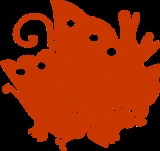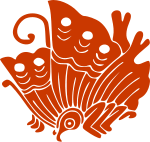
Taira clan
Encyclopedia

- For other uses of the word Taira, Hira see Taira (disambiguation)Taira (disambiguation)The word Taira or Hira in Japanese can mean a variety of things:*Taira clan.*Taira, Toyama : a village in Toyama prefecture, Japan.*Taira: the center of Iwaki City, Eastern Fukushima prefecture....
The was a major Japanese clan of samurai
Samurai
is the term for the military nobility of pre-industrial Japan. According to translator William Scott Wilson: "In Chinese, the character 侍 was originally a verb meaning to wait upon or accompany a person in the upper ranks of society, and this is also true of the original term in Japanese, saburau...
in historical Japan.
In reference to Japanese history
History of Japan
The history of Japan encompasses the history of the islands of Japan and the Japanese people, spanning the ancient history of the region to the modern history of Japan as a nation state. Following the last ice age, around 12,000 BC, the rich ecosystem of the Japanese Archipelago fostered human...
, along with Minamoto, Taira was a hereditary clan name bestowed by the emperors of the Heian Period
Heian period
The is the last division of classical Japanese history, running from 794 to 1185. The period is named after the capital city of Heian-kyō, or modern Kyōto. It is the period in Japanese history when Buddhism, Taoism and other Chinese influences were at their height...
to certain ex-members of the imperial family when they became subjects. The Taira clan is often referred to as or , using the character's Chinese reading hei.
Offshoots of the imperial dynasty, some grandsons of Emperor Kammu
Emperor Kammu
was the 50th emperor of Japan, according to the traditional order of succession. Kammu reigned from 781 to 806.-Traditional narrative:Kammu's personal name was . He was the eldest son of Prince Shirakabe , and was born prior to Shirakabe's ascension to the throne...
were first given the name Taira in 825 or later. Afterwards, descendants of Emperor Nimmyō
Emperor Nimmyo
was the 54th emperor of Japan, according to the traditional order of succession. Ninmyō's reign lasted from 833 to 850.-Traditional narrative:Ninmyō was the second son of Emperor Saga and the Empress Tachibana no Kachiko. His personal name was...
, Emperor Montoku
Emperor Montoku
was the 55th emperor of Japan, according to the traditional order of succession.The years of Montoku's spanned the years from 850 through 858.-Traditional narrative:...
, and Emperor Kōkō
Emperor Koko
was the 58th emperor of Japan, according to the traditional order of succession.Kōkō reigned from 884 to 887.- Traditional narrative :Before his ascension to the Chrysanthemum Throne, his personal name was or Komatsu-tei. He would later be identified sometimes as "the Emperor of...
were also given the surname. The specific hereditary lines from these emperors are referred to by the emperor's posthumous name followed by Heishi. i.e. Kammu Heishi.
The Taira were one of the four important clans that dominated Japanese politics during the Heian period (794-1185) - the others were the Fujiwara, the Tachibana
Tachibana clan (kuge)
The Tachibana clan was one of the four most powerful kuge families in Japan's Nara and early Heian periods. Members of the Tachibana family often held high court posts within the Daijō-kan , most frequently Sadaijin...
and the Minamoto
Minamoto clan
was one of the surnames bestowed by the Emperors of Japan upon members of the imperial family who were demoted into the ranks of the nobility. The practice was most prevalent during the Heian Period , although its last occurrence was during the Sengoku Era. The Taira were another such offshoot of...
.
The Kammu Heishi line, founded in 889 by Taira no Takamochi (a great-grandson of the 50th Kammu tenno, reigned 781-806), proved to be the most strong and dominant line during the late Heian period with Taira no Kiyomori
Taira no Kiyomori
was a general of the late Heian period of Japan. He established the first samurai-dominated administrative government in the history of Japan.After the death of his father Taira no Tadamori in 1153, Kiyomori assumed control of the Taira clan and ambitiously entered the political realm in which he...
eventually forming the first samurai
Samurai
is the term for the military nobility of pre-industrial Japan. According to translator William Scott Wilson: "In Chinese, the character 侍 was originally a verb meaning to wait upon or accompany a person in the upper ranks of society, and this is also true of the original term in Japanese, saburau...
dominated government in the history of Japan.
A great-grandson of Heishi Takamochi, Taira no Korihira, moved to Ise Province
Ise Province
or was a province of Japan including most of modern Mie Prefecture. Ise bordered Iga, Kii, Mino, Ōmi, Owari, Shima, and Yamato Provinces.The ancient provincial capital was at Suzuka...
(now part of Mie Prefecture
Mie Prefecture
is a prefecture of Japan which is part of the Kansai regions on Honshū island. The capital is the city of Tsu.- History :Until the Meiji Restoration, Mie prefecture was known as Ise Province and Iga Province....
) and established a major daimyo dynasty. Masamori, his grandson; and Tadamori, great-grandson, became loyal supporters of the cloistered tennos Shirakawa and Toba, respectively. Taira no Kiyomori, son and heir of Tadamori, rose to the position of daijō daijin (great minister of state) following his victories in the Hōgen Disturbance (1156) and the Heiji Disturbance (1160). Kiyomori managed to enthrone his infant grandson as Emperor Antoku
Emperor Antoku
Emperor Antoku was the 81st emperor of Japan, according to the traditional order of succession. His reign spanned the years from 1180 through 1185. During this time, the imperial family was involved in a bitter struggle between warring clans...
in 1180, an act which led to the Genpei War
Genpei War
The was a conflict between the Taira and Minamoto clans during the late-Heian period of Japan. It resulted in the fall of the Taira clan and the establishment of the Kamakura shogunate under Minamoto Yoritomo in 1192....
(1180-85), the Taira-Minamoto War.
Kiyomori's sons, the last of the head family of the Kammu Heishi line was eventually destroyed by the armies of Minamoto no Yoritomo
Minamoto no Yoritomo
was the founder and the first shogun of the Kamakura Shogunate of Japan. He ruled from 1192 until 1199.-Early life and exile :Yoritomo was the third son of Minamoto no Yoshitomo, heir of the Minamoto clan, and his official wife, a daughter of Fujiwara no Suenori, who was a member of the...
at the Battle of Dan-no-ura
Battle of Dan-no-ura
The ' was a major sea battle of the Genpei War, occurring at Dan-no-ura, in the Shimonoseki Strait off the southern tip of Honshū. On March 24, 1185, the Genji clan fleet, led by Minamoto no Yoshitsune, defeated the Heike clan fleet, during a half-day engagement.The Taira were outnumbered, but...
, the last battle of the Genpei War. This story is told in the early Japanese epic, The Tale of the Heike
The Tale of the Heike
is an epic account of the struggle between the Taira and Minamoto clans for control of Japan at the end of the 12th century in the Genpei War...
(Heike Monogatari).
This Kammu Heishi had many branch families including the Hōjō
Hojo clan
See the late Hōjō clan for the Hōjō clan of the Sengoku Period.The in the history of Japan was a family who controlled the hereditary title of shikken of the Kamakura Shogunate. In practice, the family had actual governmental power, many times dictatorial, rather than Kamakura shoguns, or the...
, Chiba
Chiba clan
The ' was a branch family of the Taira clan descended from Chiba no Suke, son of Taira no Tadatsune. Historically, they controlled the city of Chiba, outside Tokyo, and also an area called Soma which included the Grand Shrine of Ise....
, Miura
Miura clan
The ' was one of the branch families descended from the Taira clan. They held large fiefs, and great political influence. They were one of the primary opponents of the Hōjō family of regents, in the mid-13th century, and again at the beginning of the 16th...
and Hatakeyama
Hatakeyama clan
The ' was a Japanese samurai clan. Originally a branch of the Taira clan and descended from Taira no Takamochi, they fell victim of political intrigue in 1205, when Hatakeyama Shigeyasu, first, and his father Shigetada later were killed in battle by Hōjō forces in Kamakura...
.
Another Kammu Heishi: Takamune-ō (804-867), the eldest son of Kazurahara-Shinnō (786-853) and a grandson of Emperor Kammu, received the kabane of Taira no Ason in 825. Thus there were two Kammu Heishi families, one descended from Takamune and the other from his nephew, Takamochi (son of Prince Takami).
The Oda clan
Oda clan
The was a family of Japanese daimyo who were to become an important political force in the unification of Japan in the mid-16th century. Though they had the climax of their fame under Oda Nobunaga and fell from the spotlight soon after, several branches of the family would continue on as daimyo...
in the time of Oda Nobunaga
Oda Nobunaga
was the initiator of the unification of Japan under the shogunate in the late 16th century, which ruled Japan until the Meiji Restoration in 1868. He was also a major daimyo during the Sengoku period of Japanese history. His opus was continued, completed and finalized by his successors Toyotomi...
(1534-1582) claimed descent from the Taira, by Taira no Chikazane
Taira no Chikazane
was a Japanese warrior of the medieval era. He was the great-grandson of Taira no Kiyomori and grandson of Taira no Shigemori.Oda Nobunaga claimed descent from him.-References:#. Horst Graebner, Society for Japanese Arts. Accessed March 11, 2008.#...
, a grandson of Taira no Shigemori
Taira no Shigemori
was the eldest son of the Taira clan patriarch, Taira no Kiyomori. He took part in the Hōgen and Heiji rebellions. He died of illness in 1179....
(1138-1179).

